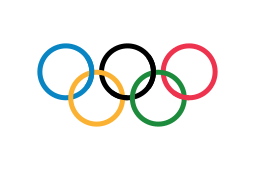1998 Winter Olympics opening ceremony
The opening ceremony of the 1998 Winter Olympics took place at Nagano Olympic Stadium, Nagano, Japan, on 7 February 1998. It began at 11:00 JST and finished at approximately 14:00 JST. The Games were officially opened by Emperor of Japan Akihito.[2]
| Date | 7 February 1998 |
|---|---|
| Time | 11:00 – 14:00 JST (UTC+9) |
| Location | Nagano Olympic Stadium, Nagano, Japan |
| Coordinates | 36.579722°N 138.165556°E |
| Filmed by | NHK, NAOC, ORTO'98 |
| Awards | [1] |
| Part of a series on the |
|
Ceremony
Many researches, such as Alan Tomlinson,[3] believe that the opening ceremony of the Winter olympics had a dramatic symbolic impact. [4]
Opening
The opening ceremony included 'Ode to Joy' being sung.[5]
At the opening ceremony, the Japanese conductor Ozawa Seiji directed the fourth movement of the Beethoven Symphony No. 9[6]. The musicians come from five continents.[7]
Parade of Nations
The flag bearers of 72 National Olympic Committees entered the stadium[8] informally in single file, ordered by the English alphabet, and behind them marched the athletes with any distinction or grouping by nationality.
2,302 athletes from 72 countries and regions participated in the competition[9], including 814 female athletes and 1488 male athletes. Both the number of participating delegations and the number of athletes participating in the competition are the most ever. For the first time, Uruguay, Azerbaijan and Macedonia are the biggest events in the history of the Winter Olympics.[10] “Amoral universalism”: mediating and staging global and local in the 1998 Nagano Olympic Winter Games[11]
Opening Addresses
NAOC President Eishiro Saito delivered a speech in Japanese, welcoming everyone[12]. IOC President Juan Antonio Samaranch delivered a speech in English and the Emperor of Japan Akihito declared the Games of the XVIII Winter Olympic in Nagano opened in Japanese.[13]
Entry of the Olympic Flag
The Olympic Flag was carried around the stadium by eight former Japanese Olympians: Chiharu Igaya, Yukio Kasaya, Akitsugu Konno, Yoshihiro Kitazawa, Hatsue Nagakubo-Takamizawa, Yuko Otaka, Seiko Hashimoto, and Hiromi Yamamoto. During the raising of the Olympic flag, the Olympic Hymn was sung in Japanese by the Nagano Children's Choir.
Torch lighting
The Olympic flame was on a 49-day relay across Japan. The start of the ceremony takes place in Olympia of Greece. At the opening ceremony, Mine activist Chris Moon ran into the stadium surrounded by local schoolchildren dressed in costumes bearing colours of the flags of the winter-games record 72 countries taking part in the Olympics. Moon passes and hand over the Olympic torch to and Masako Chiba, bronze medalist for the Women's 10,000 metres at the 1997 World Championships in Athletics
in Athens, and ran into the stadium, next stop Takanori Kono, Masashi Abe, and Reiichi Mikata for the Nordic Combine team, next stop is Hiromi Suzuki winner of the Women's marathon at the 1997 World Championships in Athletics in Athens, she heads straight upstairs to passed the last torchbearer is Midori Ito, Olympic silver medalist of the Ladies' singles at the Figure skating at the 1992 Winter Olympics in Albertville, and champion of the 1989 World Figure Skating Championships, who will the light the cauldron.
Olympic Oaths
Japanese men's Nordic combined skier Kenji Ogiwara took the oath on behalf of all 1998 Olympic athletes in Japanese, while the officials' oath was taken by figure skating referee Junko Hiramatsu in Japanese.
Beethoven's Ode to joy
Ozawa Seiji conducts with the Soloists chorus and orchestra Beethoven Symphony No. 9 Fourth Symphony with location Brandenburg Gate, Berlin Sydney Opera House, Sydney UN General Assembly Hall, New York City Forbidden City, Beijing Cape Point, South Africa
Dignitaries in attendance









.svg.png)
Anthems


References
- Tomlinson, Alan (n.d.). "Picturing the winter Olympics: The Opening ceremonies of Nagano (Japan) 1998 and Salt Lake City (USA) 2002" (PDF). Tourism, Culture & Communication. 5 (2): 83–92. doi:10.3727/109830405774791465. Retrieved 30 April 2019.
- "Nagano 1998 Winter Olympics - results & video highlights". International Olympic Committee. 2017-11-08. Retrieved 2019-04-09.
- "Alan Tomlinson". University of Brighton.
- Tomlinson, Alan (2005). "Picturing the Winter Olympics: The Opening Ceremonies of Nagano (Japan) 1998 and Salt Lake City USA (2002)" (PDF). Tourism, Culture & Communication. 5 (2): 83–92. doi:10.3727/109830405774791465.
- Strom, Stephanie (7 February 1998). "THE XVIII WINTER GAMES: OPENING CEREMONIES; The Latest Sport? After a Worldwide Effort, Synchronized Singing Gets In". The New York Times. Retrieved 8 April 2019.
- Strom, Stephanie (1998-02-07). "THE XVIII WINTER GAMES: OPENING CEREMONIES; The Latest Sport? After a Worldwide Effort, Synchronized Singing Gets In". The New York Times. ISSN 0362-4331. Retrieved 2019-04-23.
- Super Catman (2017-01-28), 1998 Nagano Olympic Opening Ceremony, retrieved 2019-04-14
- "Aussie Olympians go surfing at Winter Olympic Games". olympics.com.au. Retrieved 2019-04-09.
- "Japan and the Olympics: Asia's First Olympic Host" (PDF). Web Japan. Retrieved April 17, 2019.
- Paquette, Jessica. "The Top 10 Opening Ceremonies in Winter Olympics History". Bleacher Report. Retrieved 2019-04-14.
- Tajima, Atsushi (2004). ""Amoral universalism": mediating and staging global and local in the 1998 Nagano Olympic Winter Games". Critical Studies in Media Communication. 21 (3): 241–260. doi:10.1080/0739318042000212710.
- "Winter Olympic Games Are Underway". www.cbsnews.com. Retrieved 2019-04-09.
- Tomlinson, A. (2005). Picturing the winter Olympics: the opening ceremonies of Nagano (Japan) 1998 and Salt Lake City (USA) 2002. Tourism Culture & Communication, 5(2), 83-92. Chicago
- Masumoto, Naofumi (1998). "Cultural aspects of the opening ceremony of 1998 Nagano Winter Olympic Games". Journal of the Philosophy of Sport and Physical Education. 20 (2): 45–53. doi:10.9772/jpspe1979.20.2_45. ISSN 0915-5104.